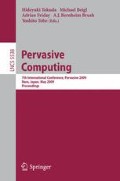Abstract
We describe a systematic, quantitative study of the benefits using context recognition (specifically task tracking) for a wearable maintenance assistance system. A key objective of the work is to do the evaluation in an environment that is as close as possible to a real world setting. To this end, we use actual maintenance tasks on a complex piece of machinery at an industrial site. Subjects for our study are active Zeiss technicians who have an average of 10 years job experience.
In a within subject Wizard of Oz study with the interaction modality as the independent variable we compare three interaction modalities: (1) paper based documentation (2) speech controlled head mounted display (HMD) documentation, and context assisted HMD documentation. The study shows that the paper documentation is 50% and the speech only controlled system 30% slower then context. The statistical significance of 99% and 95% respectively (one sided ANOVA test). We also present results of two questionnaires (custom design and standard NASA TLX) that show a clear majority of subjects considered context to be beneficial in one way or the other. At the same time, the questionnaires reveal a certain level of uneasiness with the new modality.
Access this chapter
Tax calculation will be finalised at checkout
Purchases are for personal use only
Preview
Unable to display preview. Download preview PDF.
References
Boronowsky, M., Nicolai, T., Schlieder, C., Schmidt, A.: Winspect: A case study for wearable computing-supported inspection tasks. In: Fifth International Symposium on Wearable Computers (ISWC 2001), pp. 8–9 (2001)
Bristow, H., Baber, C., Cross, J., Wooley, S.: Evaluating contextual information for wearable computing. In: Proceedings of the Sixth International Symposium on Wearable Computers, pp. 179–185 (2002)
Caudell, T., Mizell, D.: Augmented reality: an application of heads-up display technology tomanual manufacturing processes. System Sciences (January 1992)
Cheverst, K., Davies, N., Mitchell, K., Friday, A., Efstratiou, C.: Developing a context-aware electronic tourist guide: some issues and experiences. In: Proceedings of the SIGCHI conference on Human factors in computing systems, pp. 17–24. ACM Press, New York (2000)
Dey, A., Abowd, G.: Towards a Better Understanding of Context and Context-Awareness. In: CHI 2000 Workshop on the What, Who, Where, When, and How of Context-Awareness (2000)
Drugge, M., Hallberg, J., Parnes, P., Synnes, K.: Wearable Systems in Nursing Home Care: Prototyping Experience. In: IEEE Pervasive Computing, pp. 86–91 (2006)
Hart, S., Staveland, L.: Development of NASA-TLX (Task Load Index): Results of empirical and theoretical research. Human Mental Workload 1, 139–183 (1988)
Nilsson, S., Johansson, B.: Acceptance of augmented reality instructions in a real work setting. In: CHI 2008: CHI 2008 extended abstracts on Human factors in computing systems (April 2008)
Ockerman, J., Pritchett, A.: Preliminary investigation of wearable computers for task guidancein aircraft inspection. In: Second International Symposium on Wearable Computers, 1998. Digest of Papers, pp. 33–40 (1998)
Rhodes, B., Innovations, R., Menlo Park, C.: Using physical context for just-in-time information retrieval. IEEE Transactions on Computers 52(8), 1011–1014 (2003)
Schmidt, A., Beigl, M., Gellersen, H.: There is more to context than location. Computers & Graphics 23(6), 893–901 (1999)
Smailagic, A., Siewiorek, D.: Application design for wearable and context-aware computers. IEEE Pervasive Computing 1(4), 20–29 (2002)
Smith, B., Bass, L., Siegel, J.: On site maintenance using a wearable computer system. In: Conference on Human Factors in Computing Systems, pp. 119–120. ACM Press, New York (1995)
Starner, T., Schiele, B., Pentland, A.: Visual contextual awareness in wearable computing. In: Proceeding of the Second Int. Symposium on Wearable Computing, Pittsburgh (October 1998)
Sunkpho, J., Garrett Jr., J., Smailagic, A., Siewiorek, D.: MIA: A Wearable Computer for Bridge Inspectors. In: Proceedings of the 2nd IEEE International Symposium on Wearable Computers, p. 160. IEEE Computer Society Press, Washington (1998)
Webster, A., Feiner, S., MacIntyre, B., Massie, W., Krueger, T.: Augmented reality in architectural construction, inspection and renovation. In: Proc. ASCE Third Congress on Computing in Civil Engineering, pp. 913–919 (1996)
Author information
Authors and Affiliations
Editor information
Editors and Affiliations
Rights and permissions
Copyright information
© 2009 Springer-Verlag Berlin Heidelberg
About this paper
Cite this paper
Kunze, K., Wagner, F., Kartal, E., Morales Kluge, E., Lukowicz, P. (2009). Does Context Matter ? - A Quantitative Evaluation in a Real World Maintenance Scenario. In: Tokuda, H., Beigl, M., Friday, A., Brush, A.J.B., Tobe, Y. (eds) Pervasive Computing. Pervasive 2009. Lecture Notes in Computer Science, vol 5538. Springer, Berlin, Heidelberg. https://doi.org/10.1007/978-3-642-01516-8_25
Download citation
DOI: https://doi.org/10.1007/978-3-642-01516-8_25
Publisher Name: Springer, Berlin, Heidelberg
Print ISBN: 978-3-642-01515-1
Online ISBN: 978-3-642-01516-8
eBook Packages: Computer ScienceComputer Science (R0)

